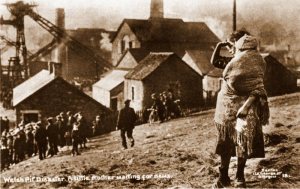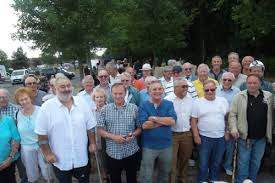October 14th marks the centenary of the worst mining disaster in British history. This involved the death of 440 men and boys at the Universal Colliery in Senghenydd – 439 miners and one rescue worker. The death toll was part of the overall number of 1752 miners who died that year.
The background is important to an understanding of the disaster in that it followed a period when the safety of miners had been the subject of Parliamentary debate and legislation. The Coal Mines Act 1911 specified standards in respect of managers, safety qualifications and inspections and the provision of safety lamps and adequate ventilation. In the Parliamentary debates in November 1911 there had been disagreements about some aspects of mine safety but there was a general view, endorsed by the Miners’ Federation of Great Britain, that the Act offered the possibility of increased safety standards. The mine owners, the Universal Steam Coal Company, a part of Lewis Merthyr Consolidated Ltd, were required to make improvements by 1 January 1913 but requested a delay until September. By the time of the accident in October the work had not been carried out.

With thanks to Fionn Taylor/Billy Williams, http://www.healeyhero.co.uk
The explosion happened at 08.10 at a time when 950 miners were underground and, although local rescue workers were soon on the scene, the recovery was hampered by large fires, thick smoke and roof falls. 439 miners died, including a large number of 14 year olds. After three weeks, only one third of the victims had been brought to the surface and 11 bodies were never recovered. The inquest in January 1914 returned a verdict of ‘accidental death’.
An Official Inquiry was held in 1914 and failed to offer a definitive judgement on the causes of the explosion but both the Company and the Colliery Manager were prosecuted under the Coal Mines Act 1911. The manager was charged with 17 offences and the Company four, and guilty verdicts were returned in respect of eight matters for the manager and one for the company. For the offence most likely to have caused the explosion – the accumulation of coal dust – the manager, Edward Shaw was fined £5. Including the other offences the total was £24. The Company itself was found guilty on only one count – the failure to undertake ventilation work – and fined £10. On the basis of these fines the local newspaper calculated just how small the value of the life of a miner was.
Senghenydd Colliery had been the site of a previous mining disaster in 1901 when 81 out of 82 miners had died and when there had also been an explosion. The Colliery finally closed in 1928 when the workforce was given one day’s notice of closure.
The disaster showed that whilst legislation had been passed with the intention of improving the safety of miners it was undermined both by companies arguing that improvements were too costly to be introduced right away, and by a critical lack of Inspectors. The struggle for safety in the mines continued to be pursued by the Miners’ Federation but many thousands more miners died and continue to do so in mines around the world.
In Senghenydd, the Aber Valley Heritage Museum has a display on the 1913 disaster. Resources at the Museum include mining related objects, photographic displays, archive films and interactive touch-screens.
Further Information
The WCML has a wealth of material on the Miners’ Federation of Great Britain and a volume of the work of David Owen looking at mining disasters in South Wales.
Two Web sites offer a wealth of material on the disaster and the effect on the local community:
www.healeyhero.co.uk/rescue/pits/Universal/Universal1.htm#top This includes a roll call of all the known names of those who were killed at Senghenydd
www.welshcoalmines.co.uk/GlamEast/Senghenydd.htm
The National Museum of Wales site contains material on Senghenydd and a link to the Official Inquiry Report:
www.museumwales.ac.uk/en/rhagor/article/senghenydd/
David Hargreaves, Library volunteer
